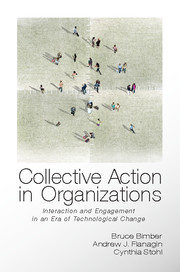Book contents
- Frontmatter
- Contents
- List of Figures and Tables
- Preface
- 1 Involvement in Organizational Collective Action in an Era of Technological Change
- 2 The Contemporary Media Environment and the Evolution of Boundaries in Organization-based Collective Action
- 3 The Collective Action Space
- 4 The American Legion, AARP, and MoveOn in Collective Action Space
- 5 Exploring Collective Action Space
- 6 Participatory Styles, the Individual, and the Contemporary Organization
- Appendix a Interaction and Engagement
- Appendix b Predicting Contribution, Identification, and Trust by Organization
- Appendix c Descriptive Statistics for the Participatory Styles
- References
- Index
5 - Exploring Collective Action Space
Published online by Cambridge University Press: 05 June 2012
- Frontmatter
- Contents
- List of Figures and Tables
- Preface
- 1 Involvement in Organizational Collective Action in an Era of Technological Change
- 2 The Contemporary Media Environment and the Evolution of Boundaries in Organization-based Collective Action
- 3 The Collective Action Space
- 4 The American Legion, AARP, and MoveOn in Collective Action Space
- 5 Exploring Collective Action Space
- 6 Participatory Styles, the Individual, and the Contemporary Organization
- Appendix a Interaction and Engagement
- Appendix b Predicting Contribution, Identification, and Trust by Organization
- Appendix c Descriptive Statistics for the Participatory Styles
- References
- Index
Summary
In the beginning of Chapter 4, we explored how the members of The American Legion, AARP, and MoveOn are distributed rather widely within the collective action space. We then observed which characteristics of members are associated with their contributions to collective goals, identification, and organizational trust across each organization separately. In the present chapter, we look at these relationships from the perspective of collective action space. Rather than treating the members of each organization as distinct from one another, we combine them based on their shared location within the space, so that their interaction and engagement become the primary features defining them as members.
Recall that in the collective action space, interaction with organizational members addresses the degree to which people have personal interactions with other members. We argued that an environment saturated with digital media provides greater opportunities to choose whether to interact personally with others using tools within and outside of organizations, and Chapter 4 showed that there is a great deal of variation within each organization. The second dimension, engagement with the organization, addresses the degree to which members actively participate in the direction, decision, and goals of the organization. We theorized that diminished boundaries and increased agency allow those who are inclined toward entrepreneurialism to find ways to influence the organization, or at least to feel this is the case. Once again, Chapter 4 showed a great deal of within-organization variation on this dimension.
- Type
- Chapter
- Information
- Collective Action in OrganizationsInteraction and Engagement in an Era of Technological Change, pp. 140 - 164Publisher: Cambridge University PressPrint publication year: 2012



